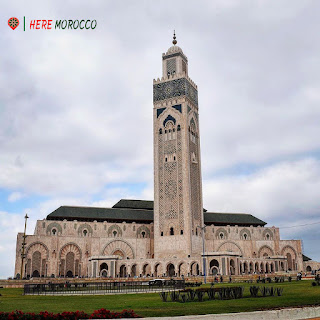HASSAN II MOSQUE OF CASABLANCA
After Mecca Mosque, the Hassan II Mosque in Casablanca is the second highest religious monument in the world. The minaret of this mosque is really huge at 210 meters above sea level. However, this is not the only reason why mosques are works of art.
Hassan II Mosque in the historical context:
It is the largest mosque in Morocco. Inspired by a verse from the Koran, which says "God's throne is built on water," almost half of the mosque's surface is above the water. Part of the area is made of glass, so that believers can kneel directly on the sea.
It was built during the reign and guidance of the late Hassan II. Construction is planned on the site of the original municipal swimming pool, which began on July 12, 1986, and after 7 years of work, an inauguration ceremony was held on August 30, 1993.
Because the mosque is located by the sea, the foundation needs 26,000 cubic meters of concrete and 59,000 cubic meters of sand and stone to resist the effects of swelling. However, the stability of the marine protection structure is insufficient, and since October 2006, extensive engineering has been carried out to strengthen the dam. The Associated Press found that despite ongoing maintenance, the Hassan II mosque showed that it was subject to very strict climatic restrictions (expansion, humidity, spray) and showed signs of aging in early 1998 (cracks, shutter shutters dropped).
Eight 220-ton cranes and twelve mobile cranes were installed to construct buildings with chapels, minarets and mosques.
A crane with a recorded height of 210 m was installed to build the minaret. The structure of the entire mosque is made of reinforced concrete and decorated with Moroccan crafts. The realization of the whole work mobilized about 35,000 workers and craftsmen who worked 50 million hours.
At least 26,000 cubic meters of high-performance concrete and 60,000 cubic meters of rock are used to resist the effects of swelling. This magnificent mosque offers great views of the Atlantic Ocean.
The ceiling of the prayer hall is 3,400 square meters and 1,100 tons of movable roof, which can be moved within five minutes with the help of a chain storage system. After the roof is closed, the prayer hall will be illuminated by 50 chandeliers and 8 Venetian Murano wall lamps. The largest diameter is six meters, the height is ten meters, and the weight is 1200 kg.
The roof needs to be installed with 300,000 bricks. The Bouygues Group (main contractor) is specially made of cast aluminum and imitates the traditional glazed tiles of Fez, but the weight is reduced by four times. Compared with conventional tiles with higher reliability performance, the weight of these tiles has increased by 65%.
In terms of finishing and religious supplies, craftsmen from the Kingdom helped cover 53,000 square meters of wood carving and over 10,000 square meters of Zellige paint, representing 80 original patterns. 1,500 artists fully processed the carved and painted plaster on a site of more than 67,000 square meters.
The mosque is decorated with 124 marble fountains and pools. The speakers and lights are designed by Philips. It has a laser beam that shows Mecca has a range of 30 kilometers.
The prayer hall covers an area of two hectares and is divided into two floors: the first floor is divided into three male symmetrical boats, which can accommodate 20,000 people, and the attic is female, with an area of 3500 square meters.
Hassan II Mosque The tallest minaret in the world:
All these works consecrate a style that has become classic. With the reign of His Majesty King Hassan II, is born in Morocco a profusion of daring project which makes it possible to find, even to exceed the ambitions of the greatest builders of the scope of the Umayyads al-Walid in the East or Abd Al-Rahmân 1st in Andalusia and Ottoman Ahmed 1st, founder of the Blue Mosque, or of the almohade al-Mansour.
If it demonstrates today more than ever this capacity to assimilate external influences, the Hassan II Mosque also reflects a new propensity in accordance with the technological know-how which is called to make more effective, more present a past hitherto passively imitated because of that, more respected than mastered, considered with nostalgia. While remaining faithful to traditional inspiration, the Hassan II Mosque uses all the advanced technological achievements and thus reflects the personality of His Majesty the King firmly attached to the spirit of contemporary civilization as well as to the teachings of Islam.
In fact, the Hassan II Mosque is a true homecoming. The quote from al-Idrîssî about the Great Mosque of Damascus seems to us singularly still valid in this last decade of the twentieth century: "there is a Mosque like no other in the world, nor any such beautiful proportions, neither none as solidly constructed, neither none as vaulted with safety, neither none more wonderfully traced, nor none as admirable decorated with gold mosaic and various designs, with enameled tiles and polished marbles. "
Thus, lobed arcs of Almoravid inspiration, turned, assembled, painted and engraved wood, dear to the Merinids, floral decorations, and inscriptions on chiselled plaster intertwine harmoniously with the new patterns and chromies unheard of in our tradition.
The Hassan II Mosque undeniably marks the continuity of a renewed ancestral art and bears the sign of innovations due not only to technical reasons but also to the fruitful exploration of new aesthetic possibilities.











0 Comments